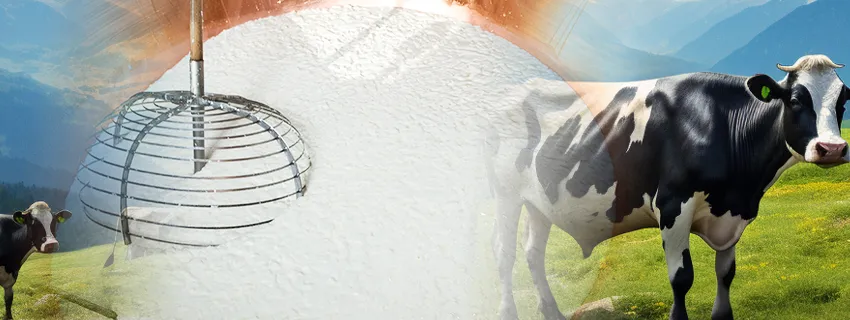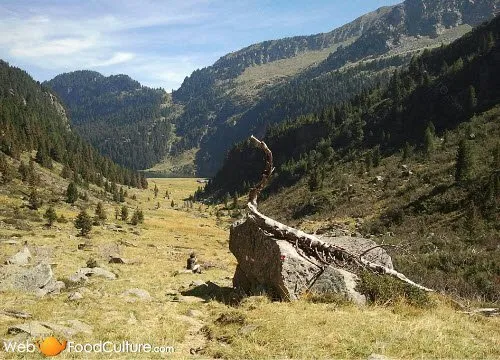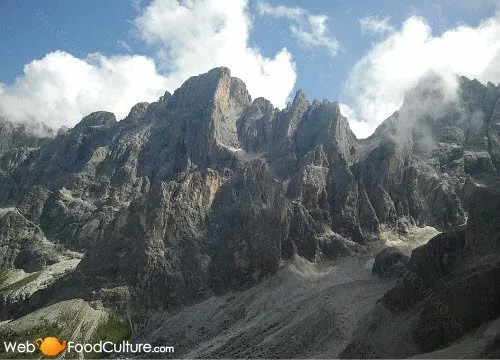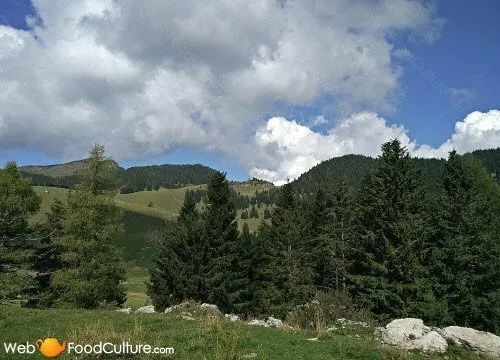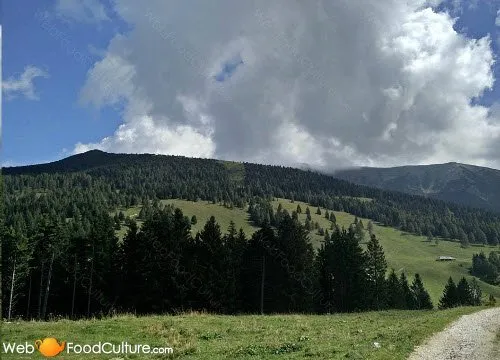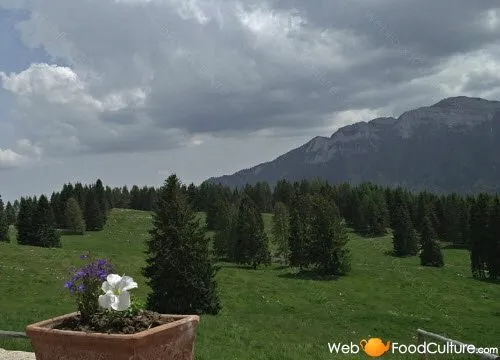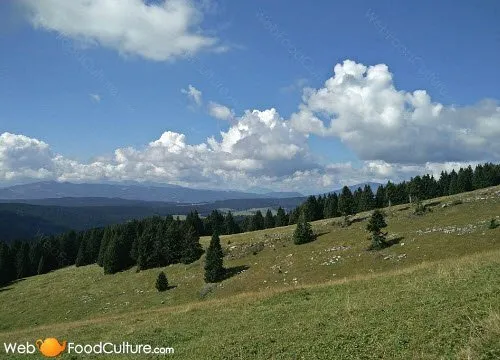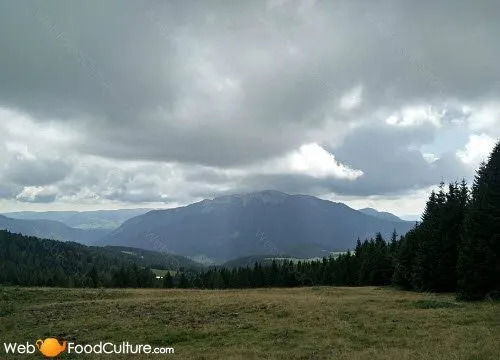Published:
Author: Antonio Maria Guerra
Asiago Cheese
HISTORY, INFO, PLACES, INTERESTING FACTS

Asiago cheese, one of the most appreciated dairy specialties from Italy, takes its name from the famous plateau located in the north-eastern part of the peninsula. Let’s find out its history and its different types. Let’s try to understand what makes it worthy of the PDO label: the Protected Designation of Origin.

The history of Asiago cheese.
The first records of the production of cheese on the Asiago plateau date back to around the year 1000 (*1): such an ancient tradition should not surprise, given the great quality of the pastures that have always characterized this area.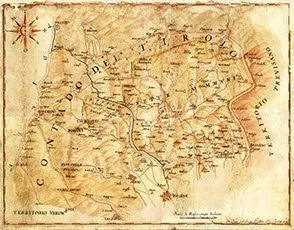 At the time there was only sheep farming (*2): thanks to the delicious milk of these animals the ‘pegorin’ (*3) was born, considered by many the ancestor of ‘Asiago’. It goes without saying that these two kinds of cheese are actually very different from each other: for example, Asiago is made with cow milk. After all, it was necessary to wait until the 16th century for the introduction of cattle breeding (*4) and until the 17th century for the invention of the cheese-making technique largely used still today (*5).
At the time there was only sheep farming (*2): thanks to the delicious milk of these animals the ‘pegorin’ (*3) was born, considered by many the ancestor of ‘Asiago’. It goes without saying that these two kinds of cheese are actually very different from each other: for example, Asiago is made with cow milk. After all, it was necessary to wait until the 16th century for the introduction of cattle breeding (*4) and until the 17th century for the invention of the cheese-making technique largely used still today (*5).
From the Mid-Nineteenth Century, there was a gradual depopulation of the plateau, this phenomenon further increased  in the Early Twentieth Century due to the beginning of the First World War and the resulting transformation of the grazing lands into battlefields. All this led to the extension of the production area of Asiago cheese, which started to include the area on the slopes of the plateau, a portion of the surrounding plains and several ‘malghe’ (mountain huts) on the hills of Trentino Region.
in the Early Twentieth Century due to the beginning of the First World War and the resulting transformation of the grazing lands into battlefields. All this led to the extension of the production area of Asiago cheese, which started to include the area on the slopes of the plateau, a portion of the surrounding plains and several ‘malghe’ (mountain huts) on the hills of Trentino Region.
In 1955 the Asiago received its first important recognition: the Typical Denomination (‘Denominazione Tipica’). In 1978 the EU assigned it the Protected Designation of Origin, also known as “PDO” (*6). The following year the Consortium for the Protection of Asiago Cheese (Consorzio per la Tutela del Formaggio Asiago) was born.
Notes:
*1: It could have started much earlier;
*2: Sheep breeding was of fundamental importance for the local economy: from these animals, in addition to milk, it was possible to get wool;
*3: The name ‘Pegorin’ derives from ‘pecora’: the Italian for ‘sheep’;
*4: During the 16th Century, cattle breeding almost completely replaced sheep breeding;
*5: The first type of Asiago to be produced was the ‘Asiago d’allevo’, the seasoned one. ‘Pressed Asiago’ (‘Asiago pressato’), the ‘fresh’ one, started to be produced at the beginning of the 20th century;
*6: In Italian acronym is ‘DOP’ (Denominadione di Origine Protetta);
In this article we’ll show you the production method currently used for Asiago cheese. To read it, please click this LINK.

Asiago Cheese
THE MOST TRADITIONAL PRODUCERS
This article is the result of collaboration between WebFoodCulture and the Consorzio Tutela Formaggio Asiago, organization gathering the most traditional producers of the famous cheese.



The types of Asiago cheese.
There are two main types (*1) of Asiago cheese:
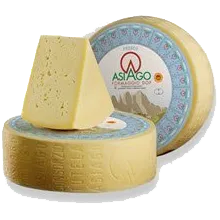
‘Fresh’ Asiago, also known as ‘pressed Asiago’. It’s the type to which much of the international success of this cheese is owed since the beginning of the 20th century.
- Production: only full-fat milk is used. This type of cheese needs from 20 to 40 days of seasoning;
- Color: very pale white / straw yellow;
- Structure: soft and elastic;
- Holes: marked and irregular;
- Taste: sweet and delicate, vaguely aromatic, it may remind freshly milked milk;
- Aromas: butter / yoghurt;
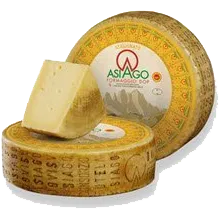 ‘Seasoned’ Asiago, also known as ‘Asiago d’Allevo’:
‘Seasoned’ Asiago, also known as ‘Asiago d’Allevo’:
- Production: only semi-skimmed milk is used. This type of cheese needs at least 3/4 months of maturation. Aging can far exceed 15 months;
- Color: straw yellow;
- Structure: progressively more compact with seasoning. Asiago Stravecchio is friable;
- Holes: sparse. Small / medium size;
- Taste: intense. With aging it becomes stronger and slightly spicy;
- Aromas: hints of dried fruit;
It’s the most ‘ancient’ type, dating back to the Middle Ages. Fresh Asiago was born later, thanks to the evolution of the dairy technique.
‘Seasoned’ Asiago, in relation to aging, is available in three different types:
- Asiago Mezzano (from 4 to 10 months);
- Asiago Vecchio (from 10 to 15 months);
- Asiago Stravecchio (more than 15 months);
Notes:
*1: Starting from 2020, a new type ‘Fresh’ Asiago is available: the Asiago PDO Fresco Riserva. This requires at least 40 days of aging.

The Asiago plateau, home of Asiago cheese.
The Asiago plateau is a vast plain located in the Vicentine Pre-Alps at an average altitude of 1300 meters. Originally inhabited by the ‘Cimbri’ people, it’s also known as the ‘Plateau of the Seven Municipalities’ because, since ancient times, its territory was divided into seven districts (Conco, Enego, Foza, Gallio, Lusiana, Roana e Rotzo), confederated in a small independent nation, the ‘League of Seven Sister Lands’ (la ‘Lega delle Sette Terre Sorelle’).
Read more
In this regard, it’s interesting to recall the words of the famous Italian writer Mario Rigoni Stern:
“In the territory of the Seven Municipalities there are no noble’s castles, no lord’s villas nor bishop’s cathedrals, for the simple fact that the land belongs to the people and its fruits, as dictated by the ancient customs, belong to everyone”.

“WHAT HAPPENS TO THE HOLES WHEN THE CHEESE IS GONE?”
(Bertold Brecht)

The shape of Asiago cheese.
Asiago cheese is sold in wheels with a diameter of about 30/35 centimeters and 10 centimeters high; their weight is, more or less, 10 kilos.
Read more
The name ‘Asiago’ and the PDO mark (Protected Designation of Origin) are branded on the side, also known as ‘scalzo’. Each wheel shows a number corresponding to its factory and a special code that makes it possible to trace information such as, for example, the date of production.
The Asiago landscapes.
As often happens when dealing with high quality food and wine products, the territories in which these specialties are born offer to the visitor also unforgettable views. Asiago and its cheese are no exception.

The PDO mark of Asiago cheese.
In the month of June 1996 Asiago cheese was awarded the PDO mark (Protected Designation of Origin). This mark, assigned by the European Union, certifies and guarantees the quality of an agri-food product, attesting its compliance with a specific guideline (‘disciplinare’).
Read more
The guideline contains a series of rules concerning, for example, the place of origin, the ingredients and the production phases: factors contributing to making a specialty unique and therefore worthy to be protected.

Wine and Asiago cheese: pairings.
The right wine to pair with a portion of Asiago depends very much on its type:
- ‘Fresh Asiago’ ( or ‘pressed Asiago’): a good choice could be a white wine, soft and light, with a fair acidity. For example a ‘Soave’ or a ‘Vernaccia di San Gimignano’;
- ‘Seasoned Asiago’ ( or ‘Asiago d’allevo’): the more seasoned is the cheese, the more structured should be the wine. For example, a good choice to accompany a medium-aged Asiago could be a ‘Cabernet dei Colli Berici’ or a ‘Bardolino’;

Consorzio Tutela Formaggio Asiago: contacts.
Official website: www.asiagocheese.it
Mail: info@formaggioasiago.it
Tel.: +39 0444 321758
Copyright information.
The images displayed in this page belong to WebFoodCulture and to the Consortium for the Protection of Asiago Cheese, with the exception of:
Public Domain images
- Vicenza, map, XVII secolo, G.Dall’Acqua (Wikipedia Link) {PD-Art} {PD-US}
- Asiago, the Kaiser visits his troops, 1917 (Wikipedia Link) {PD-Art} {PD-US}
- PDO Logo (Wikipedia Link)
Creative Commons images
- Bertolt Brecht, 1954, German Federal Archives, image belonging to the German Federal Archive (Wikipedia Link)

